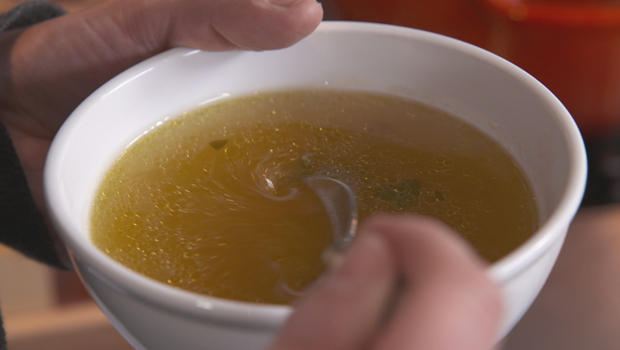Potlikker…Liquid GOLD!
I know I don't need to spend any time or article space talking about why greens are so good for you. Their health benefits are the foundation for their growing popularity. From kale to collards to turnips, we've learned to embrace their nutrient-packed bitterness.

So with the commitment to eat more greens firmly in our hearts, here's a greens-related tip I learned from listening to an NPR (National Public Radio) interview some years ago: When you're cooking up a big pot of greens, don't toss out what may be the most nutritious part — the brothy water that's left in the pot.
Lots of the beneficial nutrients cook out of the greens. And what's left? Well, if you learned to cook in a traditional Southern kitchen, you'd call it "potlikker" (aka liquid gold!).
Chef James Huff of Pearl Dive restaurant was the interviewee. He was explaining why he loved potlikker and all the many things you can do with it. During this particular interview, he was ladling up some of this precious liquid fresh from a steaming pot of sauteed collards and kale.

Alison Aubrey was the interviewer, and she was explaining how some people drink potlikker as a tonic or add it to their daily green smoothie. Others use it as a soup or stew base. And James Huff, chef de cuisine at Pearl Dive in Washington, D.C., who learned his trade in some of New Orleans' top kitchens, uses potlikker to create some incredible entrees.

For instance, he takes the leftover liquid from cooking collards and reduces it with a sauté of garlic, shallots, tomato concasse, chicken stock, black-eyed peas and clams, then pours it over an entire grilled fish.
[TIME OUT: What the heck is tomato concasse? It’s from the French concasser, "to crush or grind", and is a cooking term meaning to rough chop any ingredient, usually vegetables. This term is particularly applied to tomatoes, where tomato concasse is a tomato that has been peeled, seeded (seeds and skins removed), and chopped to specified dimensions. Thank you, Wikipedia.]

Back to the subject. So, how about nutrient loss? Well, some of the vitamins in greens are water soluble. Take, for instance, vitamin C. Researchers evaluated the total flavonoid and vitamin content of fresh spinach. In their study they found that boiling extracted 50 percent of total flavonoids and 60 percent vitamin C into the cooking water. Thus, we’re not gonna throw the cooking water away ever again, right? This stuff really is liquid gold!
And one more thing: In order to maximize the amount of nutrients you're getting from your food, sometimes you have to add a little fat.

For instance, carotenoids are fat-soluble. Those are the pigments that give red, yellow or orange coloring to food and are also found in dark green vegetables. Carotenoids convert to vitamin A in the body, and your body is going to absorb more of them if you eat them with a little oil or other fat.
So, how would a professional cook a pot of greens? Here is Chef James Huff's recipe (and notice the addition of fat, as found in the bacon and ham hock). Enjoy, y'all!

CLASSIC COOKED GREENS
2 pounds greens cut into thick ribbons (mustard, kale, collard or turnip)
1 smoked ham hock
1 Spanish onion, julienned
1 cup diced bacon
1 teaspoon red pepper flakes
2 teaspoons sugar
2 cups water or chicken stock
In a saute pot, fry up bacon until crispy, add ham hock and onion. Saute until onions are translucent. Add chili flakes, sugar and greens. Saute briefly, then add the liquid (water or stock). Cook down (covered) over low heat until greens are tender. You may need to add more liquid as necessary. Adjust seasoning to personal taste (vinegar, salt, pepper, etc.).
And, of course, what's left in the bottom of the pot? You now know it's potlikker, so put it to good use!
- www.cbsnews.com
- www.addapinch.com
- www.npr.org
- www.nitrituiontofruition.com
- www.steamykitchen.com
- www.foodnetwork.com
 Alice Osborne
Alice Osborne
Weekly Newsletter Contributor since 2006
Email the author! alice@dvo.com
